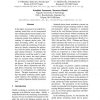Free Online Productivity Tools
i2Speak
i2Symbol
i2OCR
iTex2Img
iWeb2Print
iWeb2Shot
i2Type
iPdf2Split
iPdf2Merge
i2Bopomofo
i2Arabic
i2Style
i2Image
i2PDF
iLatex2Rtf
Sci2ools
ACL
2006
2006
A Clustered Global Phrase Reordering Model for Statistical Machine Translation
In this paper, we present a novel global reordering model that can be incorporated into standard phrase-based statistical machine translation. Unlike previous local reordering models that emphasize the reordering of adjacent phrase pairs (Tillmann and Zhang, 2005), our model explicitly models the reordering of long distances by directly estimating the parameters from the phrase alignments of bilingual training sentences. In principle, the global phrase reordering model is conditioned on the source and target phrases that are currently being translated, and the previously translated source and target phrases. To cope with sparseness, we use N-best phrase alignments and bilingual phrase clustering, and investigate a variety of combinations of conditioning factors. Through experiments, we show, that the global reordering model significantly improves the translation accuracy of a standard Japanese-English translation task.
| Added | 30 Oct 2010 |
| Updated | 30 Oct 2010 |
| Type | Conference |
| Year | 2006 |
| Where | ACL |
| Authors | Masaaki Nagata, Kuniko Saito, Kazuhide Yamamoto, Kazuteru Ohashi |
Comments (0)

